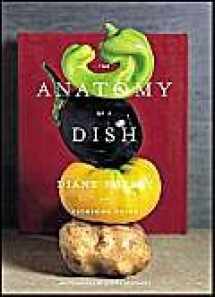
The Anatomy of a Dish
Book details
Summary
Description
The renowned chef of New York's Verbena restaurant shows how to build a dish—and a menu—from vegetables on up in this innovative cookbook that looks at flavors through a botanical prism.
What do Poached Eggs in Asparagus Nests, Leek and Apple Hash, and Sauteed Scallops with Onion Pan Gravy have in common? Aspargus, leeks, and onions (along withe shallots, garlic, and chives) are all part of the botanical family Liliaceae.
Diane Forley's fascination with the properties and groupings of fruits and vegetables—in the garden, in the kitchen, and on the plate—suffuses The Anatomy of a Dish. But this is not a vegetable or vegetarian cookbook. It is a collection of the richly flavorful recipes Forley serves at her restaurant, illuminated by the culinary and botanical explorations that have led to her celebrated cooking style.
Forley, one of America's rising chefs, has arranged her book to reflect her conviction that vegetables, fruits, grains, and legumes define sensibility in cooking. Part I, which serves as the book's foundation, looks at vegetables one at a time, and details some of Forley's favoirte ways to prepare them. Cooking techniques are explained and applied to an array of vegetables to form side dishes and starting points fo rmore comlete meals. For example, artichokes are braised, shaped into griddle cakes, baked as gratins, and fried as snack chips; mushrooms are sauteed, pureed, and transformed into Forley's own Worcestershire sauce. A plentitude of notes alongside each recipe offer serving suggestions and menu-building links.
From single vegetables, the book moves on to vegetable combinations in salads, soups and stews, pastas, tarts, souffles, and breads. And then, fish, poultry, and meat are added to create dishes that The New York Times praised for being delicious yet "disarmingly simple."
Seasonal availability of ingredients inspires the recipes in the dessert chapter. These are alluring treates on their own, at any time, but they thoughtfully complement the savory dishes that precede them.
Cooking from this immensely engaging book, you'll come to expect the unexpected and be thrilled by each encounter. For example, you'll learn how plants are classified and marvel at the notion that the potato, eggplant, tomato, petunia, and the tobacco plant have much in common, starting with a five-petaled star-shaped flower. (The hugely toxic belladonna also has the same shaped flower. Is it any wonder that the Old World was reluctant to try these New World fruits and vegetables?)
Cooks who care to broaden their culinary horizons will find this side excursion into the world of botanical family trees as delicious as they'll find Forley's recipes, with their straightforward charm and exceptional soaring flavors.


We would LOVE it if you could help us and other readers by reviewing the book
Book review



